Don't wanna be here? Send us removal request.
Text
Day 17
Day 17 removed us from the noise of the city and took us into a place of peace, discipline, and reflection: the Fo Guang Shan Monastery. Located on the outskirts of Kaohsiung, it is one of the largest Buddhist monasteries in Taiwan and serves as a global hub for Humanistic Buddhism. There was a noticeable shift in atmosphere upon entering—of quiet, stillness, and carefully maintained grounds. We spent several hours exploring the monastery’s halls, statues, and exhibits. Each space had its own sense of reverence, whether it was a grand hall with a towering Buddha or a small shrine lit with incense. The attention to detail in the architecture and the symbolism behind each design made the experience visually and intellectually rich.
One of the most memorable parts of the day was participating in a traditional tea ceremony. The ceremony was slow and deliberate, every movement carried out with intention. The ceremony was not just about drinking tea—it was a meditative practice. Sitting in silence with our group, savoring each sip, I began to understand how something as simple as tea can be elevated into a form of spiritual practice.
We were invited to share a meal with the monks in the monastery’s main dining hall. The meal followed strict rules—no talking, no wasting food, and a strong emphasis on gratitude. We entered quietly, followed the monks’ lead, and took our seats in long rows facing forward. Before eating, we participated in a brief prayer and a ritual of mindfulness. The food was simple but nourishing, and eating in silence made me reflect more deeply on the act of nourishment itself. Without conversation to distract us, every bite felt more intentional. Sharing that space and rhythm with the monks offered a rare window into the discipline and humility that defines monastic life. The practices we experienced reminded me of the value of slowing down, of living with awareness, and of finding meaning in the everyday.
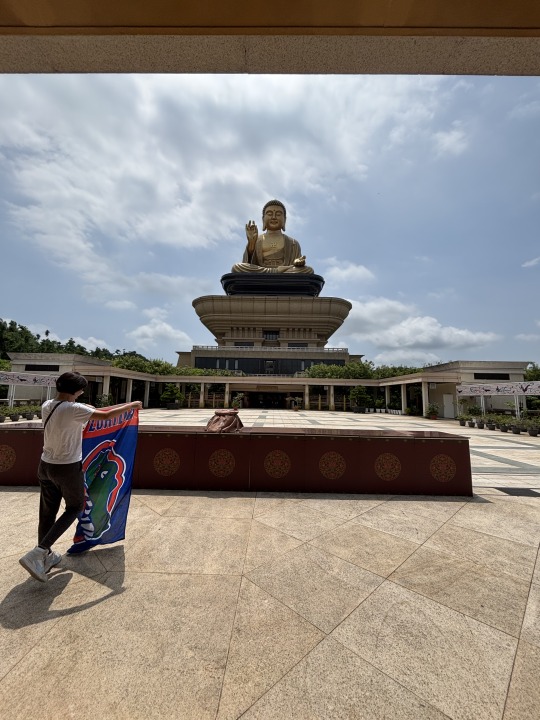
1 note
·
View note
Text
Day 16
Day 16 in Kaohsiung offered a deep dive into the scientific and artistic sides of Taiwanese culture. We started the day visiting the National Science and Technology Museum in the Sanmin District, one of the largest science museums in Asia. The scale of the building itself was very large, with floors of interactive exhibits covering everything from energy and robotics to human anatomy and transportation. I liked how the museum was clearly designed to be both educational and engaging for all ages. Families, school groups, and travelers like us went from one exhibit to the next, and the hands-on nature of the displays made the experience more immersive. While many exhibits were in Mandarin, the visuals and design still made the concepts easy to grasp, and it was interesting to see how Taiwan approaches STEM education.
In the afternoon, we visited the Kaohsiung Museum of Fine Arts, located in a peaceful area surrounded by trees and paths. The museum’s layout was spacious and calming, and it felt like a perfect environment to slow down and take in creativity. One of the highlights for me was a collection of traditional-style ink paintings depicting animals. The brushwork was delicate yet full of life, and it was amazing to see how much motion could be conveyed through minimal strokes. These works felt rooted in classical Chinese techniques but carried a modern personality that made them feel fresh and relevant.
Another exhibit that stood out was Footprints of the Walker, which focused on the concept of movement, travel, and personal reflection. The pieces in that exhibit ranged from abstract installations to video projections and mixed media art, each exploring the theme in a different way. Some installations invited you to physically move through them, blurring the line between observer and participant. I started thinking about how the act of walking—something we’ve done so much of during this trip—can become a metaphor for learning, transition, and growth.
The contrast between the science museum in the morning and the fine arts museum in the afternoon created a sort of balance. One focused on understanding how the world works, while the other offered space to reflect on how we experience it.
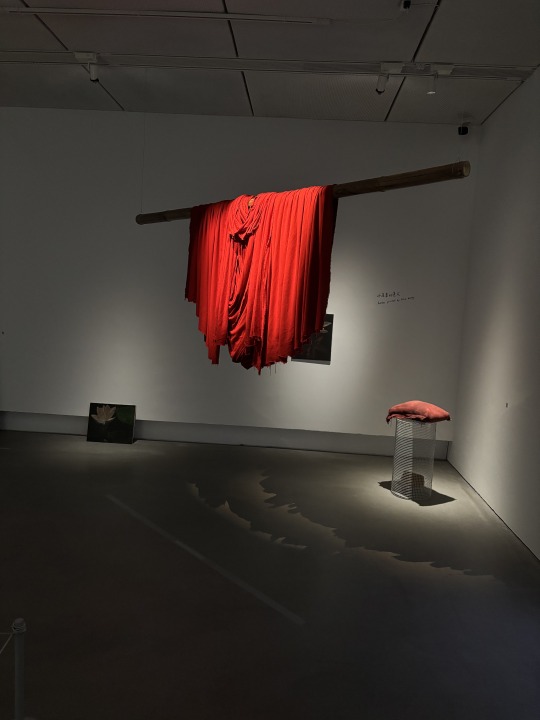
1 note
·
View note
Text
Southbound to Kaohsiung
Day 15
On Day 15, we left the familiar pace of Taipei behind and boarded the high-speed rail for Kaohsiung. The journey was a reminder of just how efficient Taiwan’s infrastructure is—the train was smooth, quiet, and incredibly fast, covering the length of the island in just a few hours. Watching the scenery shift from dense urban landscapes to more open stretches of countryside and then back into city life again gave me a sense of Taiwan’s geography and culture. Kaohsiung, located in the southern part of the island is noticeably more laid-back from the moment we arrived, offering a different rhythm compared to the capital.
After checking into our hotel, my friend and I headed out to explore the Gu Shan District, one of Kaohsiung’s more scenic and culturally rich areas. Near the waterfront, the neighborhood felt lively yet relaxed, with palm-lined streets, local businesses, and a steady breeze coming in from the harbor. For dinner, we found a local restaurant that served up seafood, traditional Taiwanese dishes, and sandwiches.
After dinner, we noticed that the restaurant next door had an outdoor bar area right on the water, so we decided to grab a couple of drinks and hang out for a while longer. The setting was ideal—dim lights, waves lapping against the dock, and a laid-back crowd of patrons. We sat for over an hour, hanging out and letting ourselves exist in the moment. These quieter, more reflective parts of the trip have been just as meaningful as the packed days of sightseeing. They’ve given me time to reflect on Taiwan’s identity. Kaohsiung is already proving to have its own unique charm, and I’m excited to see what else it has to offer.
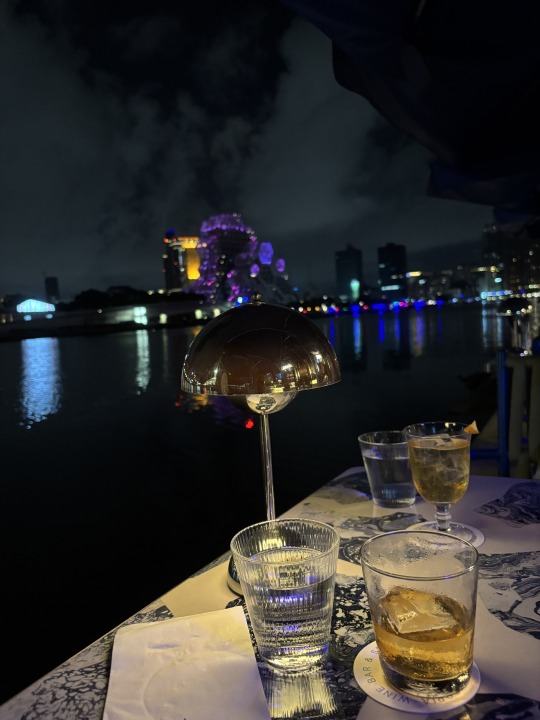
1 note
·
View note
Text
Day 13
Day 13 of our trip offered freedom to explore Taipei however we wanted. With no scheduled group activities, I saw it as the perfect opportunity to dive into the parts of the city that aligned with my personal interests. I began the day with a workout at Jin Life Gym, a cool fitness center tucked away in the heart of Taipei. The facility was well-equipped and clean, and the atmosphere reminded me of boutique gyms back in New York. It was interesting to see how similar the workout culture felt here, yet with subtle differences—like the emphasis on stretching or how meticulous everyone was about cleaning their machines. Being in that space gave me a sense of connection to the city not as a tourist, but as someone slipping briefly into local routines.
After working out, I went with my friend to Toasteria Café for some dinner, a popular restaurant known for its Mediterranean-inspired food and laid-back vibe. Located in the Da’an District, the café had a cozy, international feel to it. We shared some cuban sandwiches and pastas while speaking about everything we’d experienced so far in Taiwan. Sitting there and watching locals come and go—students, couples, groups of friends—it struck me how Taipei blends its global and local identities. The food, the music, the décor—it could’ve been anywhere in the world, but it still somehow it still felt distinctly Taiwanese.
After dinner, we wandered around the neighborhood, which was filled with trendy streetwear stores and boutique shops. We popped into a few to check out some of the local brands and designs. The streetwear scene in Taipei has a strong identity, merging traditional Asian aesthetics with modern global fashion trends. The attention to detail and creativity we saw in those shops reflected a broader cultural theme I’ve noticed here: a deep respect for individuality and self-expression.
We ended our evening at a small ice cream shop tucked away beneath a subway platform. It felt like a hidden gem—one you wouldn’t know existed unless someone told you about it or you just happened to stumble upon it. Moments like that are what make days like this so memorable.
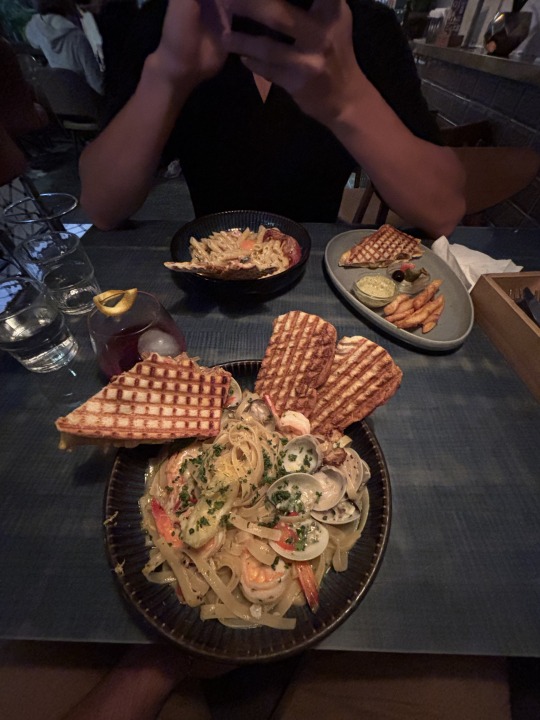
1 note
·
View note
Text
Day 12
After checking out of the Art Spa Hotel in Jiaoxi, we made our way back to Taipei, stopping along the way at the Old Street by the Bengshan River. The area had a slower, more nostalgic vibe compared to the busy cities we’ve been staying in. Small shops lined the narrow streets, many of them selling handmade goods, traditional snacks, and local teas. The river itself added a peaceful backdrop to the walk, and some parts of the town felt like they hadn’t changed in decades.
This stop felt like a final look at Taiwan’s rural identity before returning to the fast pace of the city. It was a reminder that the country isn’t just about skyscrapers and night markets—it’s also about preserving the rhythm of everyday life in smaller towns. Exploring places like Bengshan gives a fuller picture of the culture, where tradition is lived..
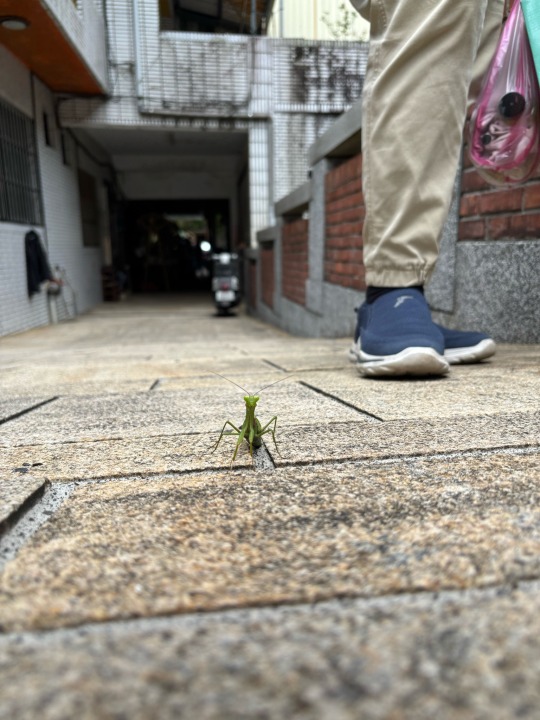
1 note
·
View note
Text
Daily Summary - Day 11
Today we arrived in the center of Jiaoxi and checked into the Art Spa Hotel, where we spent the night enjoying both the amenities and the unique atmosphere of the town. The hotel featured its own hot spring facilities, which we took full advantage of. Soaking in the mineral-rich water was both relaxing and rejuvenating, and it helped me understand why hot springs are such a cherished part of Taiwanese leisure and wellness culture.
In the evening, we headed out to explore the area and find some dinner. Afterward, myself and a buddy of mine visited a local bistro where we sampled drinks made with Taiwanese tea liqueur—a blend of traditional tea culture and modern cocktail craft. Walking around Jiaoxi at night was a memorable experience. The town is lively but relaxed, with warm lights glowing from food stalls and shops. What made the environment especially interesting was the way water flowed openly beneath the streets and sidewalks, creating a soundscape of bubbling streams. We also passed street vendors, performers, and even a spa where you could dip your feet in a pool and let small fish nibble away dead skin. The whole evening felt like an informal celebration of everyday life—playful, sensory, and about community.
Academic Reflection
My reading for the day was on Taiwanese night markets helped contextualize many of the things we saw in Jiaoxi this evening, even though Jiaoxi doesn’t host a traditional night market in the classic sense. The reading explained how night markets are more than just places to shop or eat—they're social institutions rooted in Taiwan's urban and cultural values. The section on Shi Wenbin’s “Made in Nine-City” project emphasized how night markets reflect local identities and adapt to regional differences while still sharing a broader cultural basis.
As I walked around Jiaoxi, I saw those principles in action, even outside of a formal night market setting. There was a rhythm to the town— street vendors selling snacks, local families strolling the streets, and spontaneous performances—that aligned with the night market spirit described in the reading. The focus on communal gathering, sensory pleasure, and fun is a central part of what defines Taiwanese urban life after dark. What struck me most is how normalized these experiences are in Taiwanese culture, while in most parts of my country, they’d be seen as special events or festivals. In Taiwan, they’re simply part of a daily lifestyle that celebrates shared space and spontaneous joy.
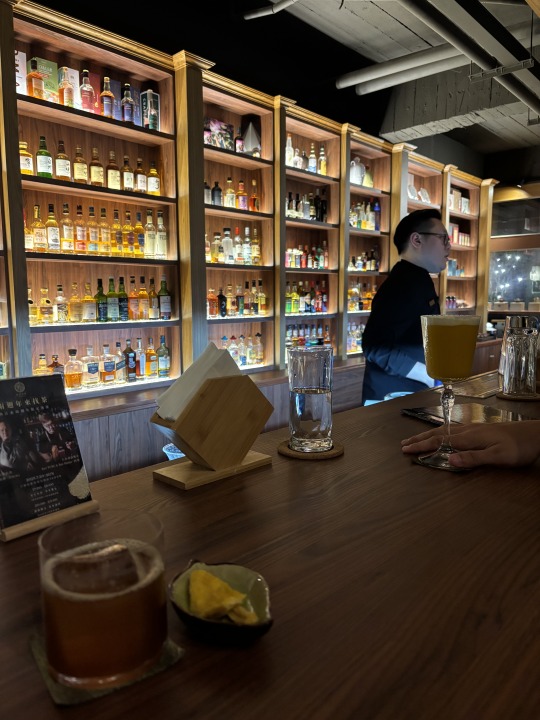
1 note
·
View note
Text
Daily Summary – July 10th
We started our day by exploring the cultural art street near our resort in the Jiaoxi region. This area was designed as a man-made replica of a traditional Taiwanese street, complete with vintage-style shopfronts, lanterns, and signage. While the setting was artificial, it successfully created an atmosphere of nostalgia and gave us a glimpse into what older urban spaces in Taiwan may have once looked like. As we walked through the area, we saw displays of traditional crafts and tried local snacks, all curated to celebrate Taiwan’s cultural heritage in a tourist-friendly way. Even though the experience felt somewhat commercial, it still helped me imagine a Taiwan of decades past and reflect on how culture can be preserved and shared in creative ways.
Later in the day, we visited a black sand beach not far from the coast. The sand, darker than I’d ever seen before, gave the landscape a dramatic and unfamiliar look. The sound of the waves and the expansive ocean view added a relaxing break to the day. That evening, we checked into The Moment Hotel in Jiaoxi. The design of the hotel was sleek and modern, with floor-to-ceiling windows that opened up to mountain views and the sound of rushing water. One unexpected encounter was finding a large huntsman spider in our room—shocking at first, but a reminder that we were in a much more natural environment than usual. It ended up being one of the most talked-about moments of the trip so far.
Academic Reflection
Although there wasn’t a new assigned reading today, the ideas from our previous discussion on Foguangshan still felt relevant. Foguangshan’s approach to preserving tradition while adapting it for modern audiences mirrors what we saw in Jiaoxi’s cultural art street. Much like Foguangshan uses contemporary media and design to make Buddhist values accessible, the replica old street in Jiaoxi uses physical space and aesthetic cues to recreate a connection to Taiwan’s past. While not religious in nature, it served a similar function: using nostalgia and curated experience to foster cultural memory in a modern setting.
The experience made me think about how Taiwan balances authenticity and tourism. Even though the street wasn’t a “real” historic site, it still carried meaning and provided an opportunity to engage with the country’s heritage. That, in itself, speaks to how cultural identity in Taiwan is actively shaped and reimagined—not just preserved in temples or museums, but recreated in everyday places for new generations to experience.
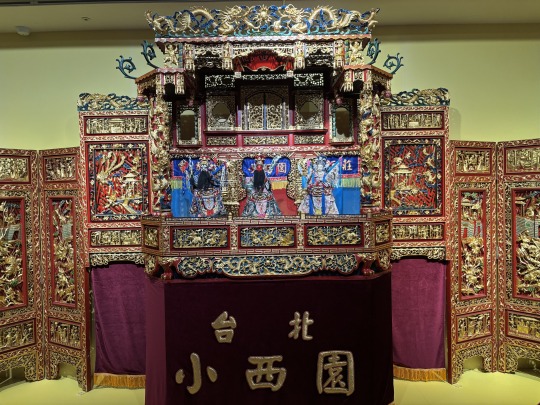
0 notes
Text
Daily Summary – July 9th
Today we traveled to Jiufen Old Street, a historic village perched on the mountains of northeastern Taiwan. The winding alleys were filled with shops selling snacks, teas, souvenirs, and handmade crafts. As we made our way through the crowds, the elevation revealed breathtaking views of the ocean below, with rooftops layered against the hillside and mist rolling over the mountains. The atmosphere felt both lively and peaceful, with a blend of nostalgia and nature that gave Jiufen a unique charm. It was easy to understand why the town is such a popular destination—it felt like a window into Taiwan’s past, but still very much alive today.
Later in the day, we visited a nearby gold mining area and explored a museum dedicated to the miners who once lived and worked there. The exhibits covered the history of Taiwan’s gold industry, including the Japanese colonial era and the harsh realities faced by laborers. One section focused on the physical demands of mining and the dangers involved, including cave-ins and health issues from prolonged exposure underground. Seeing the miners’ living quarters and tools helped me better understand the daily lives of people in that era and how the economic foundations of the region shaped its development.
Academic Reflection
Our reading for today centered on Foguangshan, one of Taiwan’s most influential modern Buddhist organizations. Founded by Master Hsing Yun, Foguangshan integrates traditional Buddhist monastic practices with an emphasis on education, social service, and international outreach. The text highlighted the organization’s massive headquarters, its modern architecture, and its commitment to making Buddhism accessible to the public through schools, hospitals, publishing, and media. Foguangshan’s model of Humanistic Buddhism seeks to bring spiritual practice into everyday life, promoting compassion, mindfulness, and community engagement in contemporary society.
Although we didn’t visit a Foguangshan site today, some of the ideas in the reading resonated with our experience in Jiufen and the gold mining museum. Jiufen’s quiet beauty and historical depth echoed the reading’s descriptions of mountain monasteries as places of reflection and memory. Similarly, learning about the suffering and perseverance of the miners called to mind the core Buddhist values Foguangshan promotes—especially compassion for those who endure hardship. Foguangshan’s efforts to bridge past and present, tradition and modernity, mirror how Jiufen preserves its mining history while evolving into a cultural and tourist hub. This made me think more deeply about how spiritual values can be reflected not only in temples, but in the way communities remember and honor their histories.
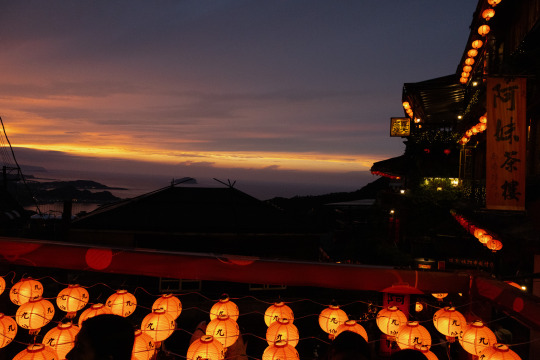
1 note
·
View note
Text
Daily Summary – July 8th
Today’s activities offered a diverse look into both Taiwan’s natural and cultural richness. We began the day at the Taipei City Zoo, one of the largest in Asia. The zoo was expansive and well-organized, featuring a wide variety of animals from different ecosystems. Highlights included the panda house, where we saw Yuan Zai, Taiwan’s beloved panda, and the Formosan animal section, which introduced us to native species like the Formosan black bear and sika deer. It was fascinating to see how the zoo balances conservation, education, and entertainment.
In the afternoon, we traveled to the Shenkeng District, a small town famous for its tofu. Walking along the old street, we saw numerous shops selling traditional snacks, handcrafted items, and tofu in every form imaginable—from stinky tofu to tofu ice cream. The highlight of the visit was a DIY tofu-making class. It was a hands-on experience where we learned about the tofu-making process from soybeans to curds, and we even got to press and shape our own tofu. The process was surprisingly delicate and detailed, and it gave me a new appreciation for something I usually take for granted. The setting, paired with the scent of tofu and bustling old street, made it a culturally immersive experience that stood out from the rest of our trip so far.
Academic Reflection
The reading for today focused on Taiwan’s artisan and craft festivals, highlighting how these events are key to preserving traditional skills in food, beverage, textiles, and other handcrafts. It emphasized how crafts are not just products—they’re cultural practices passed down through generations that reflect regional identities and values. One major theme was the idea of craft as heritage, especially when the process and knowledge are preserved alongside the final product.
Participating in the tofu-making class brought that idea to life. Tofu isn’t just a food in Taiwan—it’s a symbol of local pride in places like Shenkeng, and its preparation represents an artisanal process that connects past and present. The reading discussed how such crafts are often spotlighted in local festivals, which help build community and cultural continuity. Being part of a hands-on experience helped me see how tradition can be sustained through everyday participation, not just observation. This connection between what we read and what we did made the learning feel more grounded and memorable.
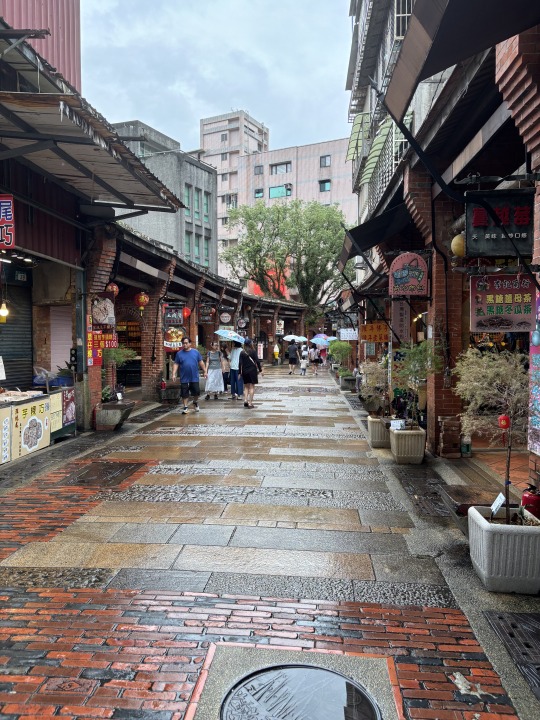
1 note
·
View note
Text
July 7 – Steam, Stories, and Street Life
Yesterday felt like a perfect blend of relaxation, history, and cultural insight. We spent the morning in Beitou, a district famous for its natural hot springs just outside of central Taipei. The first thing that hit me when we arrived was the smell—sulfur in the air, rising with the steam from the hot spring streams that cut through the lush greenery of the area. We explored the Beitou Hot Spring Museum, a beautifully preserved Japanese-era bathhouse that gave us a glimpse into how public bathing culture developed in Taiwan under Japanese rule. The interior had a calming, almost spiritual vibe, with stained glass, old photos, and a massive central bath surrounded by wooden hallways. I’d never thought of hot springs as something historical, but it made me appreciate how much they’ve shaped the area’s identity over time.
Afterward, we visited the nearby Indigenous Peoples Museum. It was smaller than the one we’d read about earlier in the week, but no less meaningful. There were exhibits on language, oral traditions, ceremonial dress, and community structure. What stood out most to me were the sections that discussed how Indigenous identities are maintained today—not just through artifacts or festivals, but in education, land rights, and political activism. Seeing how these communities continue to assert themselves in modern Taiwan helped tie everything we’ve been learning together.
That night, we visited another one of Taipei’s legendary night markets. As always, it was crowded, loud, and full of incredible smells—sizzling skewers, sweet baked goods, and fresh fruit juices. I tried a grilled rice sausage stuffed with pickled vegetables and a dessert made of crushed ice, jelly, and peanuts. The energy of the market was such a contrast to the quiet calm of Beitou earlier in the day, but both felt like essential parts of the Taiwanese experience.
Academic Reflection
The reading gave us two different lenses for understanding Taiwanese culture: the evolving experience of Indigenous peoples and the role of night markets in shaping everyday identity. At the Indigenous museum, the reading’s points about marginalization, cultural survival, and political voice became much more tangible. The displays emphasized that these communities are not static or purely traditional—they’re dynamic and forward-looking. The reading discussed how Indigenous groups have long been “othered” in national narratives, but at the museum, I saw a deliberate push to present them as central, modern participants in the story of Taiwan. It wasn’t just about preserving the past—it was about confronting the present and shaping the future.
In contrast, the night market represents a kind of cultural mixing bowl. As the reading pointed out, night markets are more than just street food—they’re deeply social spaces where tradition, trend, and innovation all collide. Being there in person, it was easy to see that. You’d find a vendor selling grilled squid next to someone with anime-themed drinks, followed by someone blending local tea with global aesthetics. The market reflects Taiwan’s unique ability to hold onto tradition while constantly remixing it for a new generation.
Both parts of the reading—and both experiences during the day—highlighted the diversity of voices that make up Taiwanese identity. Whether it’s an Indigenous elder preserving a native language or a teenager running a night market food cart, both are participating in the ongoing shaping of what Taiwan is and who gets to be seen.
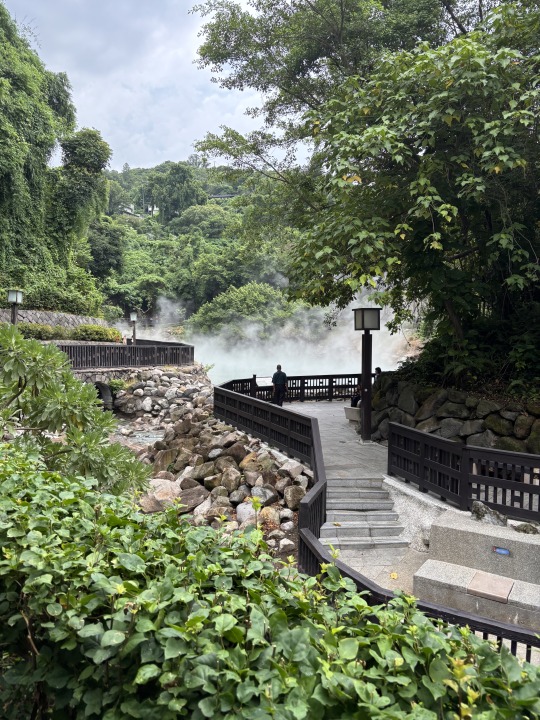
1 note
·
View note
Text
July 5 – Museums, Memory, and Pastry Soup
Yesterday was a full day of discovering Taiwan's rich and diverse cultural heritage. We started at the National Palace Museum, which houses one of the most spectacular collections of Chinese art and antiques I've ever seen. There were antique bronzes, jade sculptures, centuries-old calligraphy, and intricate porcelain items, some reaching back thousands of years. What struck me was how many of these items had been transported from mainland China during the Chinese Civil War. It made me reflect on how strongly Taiwan's identity is linked to those moments of displacement, preservation, and reinvention.
To cap off the day, we visited a Taipei night market—another bright, boisterous, and delicious adventure. I had a bowl of warm, flaky pastry soup, which was perfect after a long walk. The market was alive with people, delicious scents, games, and music—the ideal way to cap off a day of heavy history and deep meditation about Taiwan's history.
Academic Reflection
We took a break in the afternoon and visited a local cat café. It was my first time in one, and I must say that it was the ideal reset. Soft music, iced drinks, and cats casually strolling among visitors. Some took naps in corners, while others hopped into laps for attention. It was calming and weirdly grounding after the formality of the museum. Spending time in that space reminded me of how modern Taiwan seamlessly combines global trends with local hospitality—you can go from Qing period relics to sipping lattes with cats in the same day, and it all makes sense.
Although we did not visit a place directly associated to Taiwan's Indigenous Austronesian people today, our assigned reading prompted me to consider the kind of cultural narratives that are highlighted—and those that are left out. The Palace Museum displayed Chinese imperial history in great detail, strengthening Taiwan's long-standing cultural ties with the mainland. However, after reading about how Indigenous groups are frequently omitted from national memory, I saw that the exhibits made almost no reference to Taiwan's indigenous inhabitants. The story is graceful and vast, but also selective. We will be going to a museum in the next couple of days that exemplifies these things.
It made me reflect on how power influences which history are preserved and honored. The reading described how Taiwan's Indigenous peoples were long viewed as "primitive" or ornamental, occasionally exploited in official branding but rarely recognized for their genuine political and cultural significance. That absence was palpable today, especially after spending hours in a museum that begins the tale of Taiwan with imperial China. The reading made me realize that cultural preservation is never neutral; it is a choice. What is displayed, what is left out, and who gets to tell the story are all important.
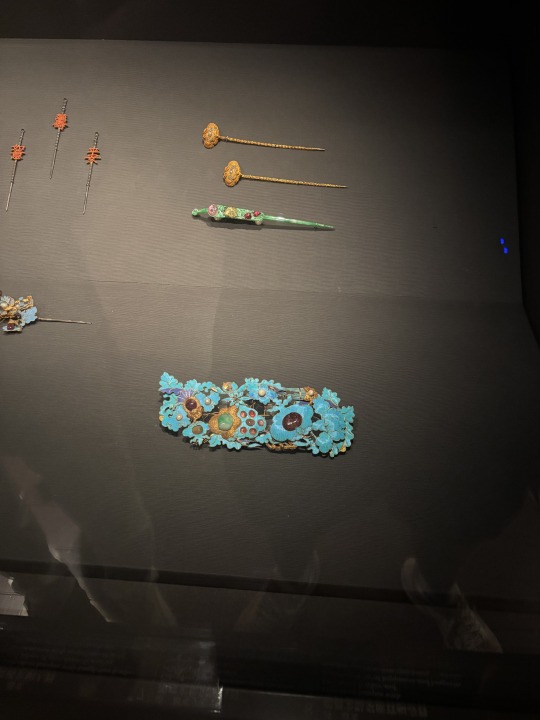
1 note
·
View note
Text
July 4 – Chiang Kai-shek and Night Market
Today was full with history, culture, and some of the tastiest food I've had yet. We began the day by visiting Chiang Kai-shek's former home, a tranquil, tree-lined estate in the heart of Taipei. Walking through the rooms where he lived and worked felt surreal—everything was so meticulously preserved, from the military outfits to the personal study area. It helped me understand how he lived not only as a politician, but also as a person. The grounds were serene, with flowers and winding roads that made the entire area feel more like a refuge than a political center.
Later in the day, we visited the Chiang Kai-shek Memorial Hall, which was much more formal and monumental. The towering white structure, the wide plaza, and the ceremonial changing of the guard all felt designed to project strength, dignity, and permanence. It was definitely a contrast to the quiet of his former home. Then, to end the day, we visited one of Taipei’s famous night markets. It was a total change of pace—noisy, colorful, full of delicious smells and packed with people. I tried fried chicken cutlets, bubble tea, and some kind of grilled mochi skewer that I still don’t fully understand, but loved anyway. It was the perfect way to wrap up a day that started heavy with history but ended with celebration and everyday life.
Academic Reflection
Today's reading was on Chiang Kai-shek's national heritage and the complex position he plays in Taiwan's present identity. He is known as both the founder of the Republic of China in Taiwan and a very controversial figure because of his autocratic reign and martial law measures. Visiting his former home helped to humanize him—the room appeared more personal and somewhat somber, as if it was about memory rather than mythology. There were hints of his military past everywhere, but there were also subtle details—photos, calligraphy, and peaceful corners—that reminded me that he was just a man living in really turbulent times.
In contrast, the Chiang Kai-shek Memorial Hall focused on legacy. The statue, the stairs, and the ceremonial guards are all large-scale structures. It is evident that the goal is to raise him to the status of national hero. However, with the reading in mind, I couldn't help but reflect critically on how that legacy is changing. We've discovered that public perception about Chiang has altered over time, particularly among younger generations who doubt his involvement in political repression and censorship. That tension was palpable when I visited the memorial in person. It continues to serve as a tourist destination and a source of national pride, but it also appears to be evolving into a historical discourse rather than a one-sided tribute.
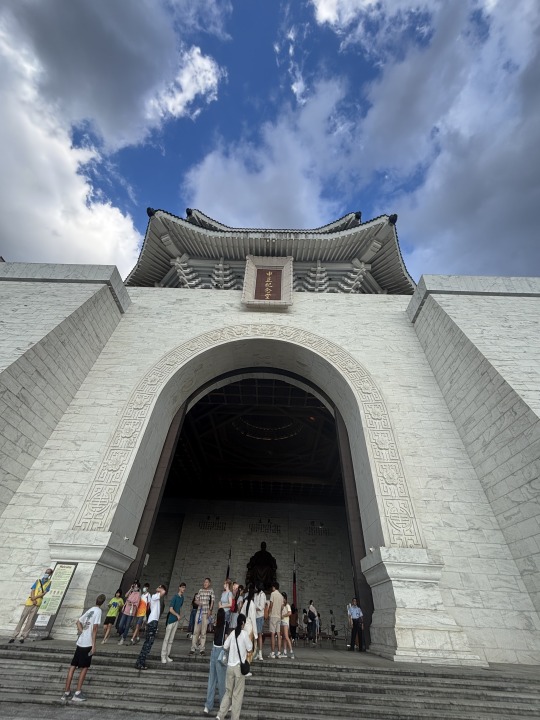
1 note
·
View note
Text
July 3 – Fort Santo Domingo and Tamsui Views
Today, we left the hustle and bustle of central Taipei and traveled north to the ancient area of Tamsui, where we visited Fort Santo Domingo. The temperature was hot and humid, but the air from the river kept it bearable—and the scenery was stunning. The fort is positioned on a hill overlooking the Tamsui River, with hazy silhouettes of mountains visible in the distance. The fort's bright red facade stood out against the blue sky, and entering through its arched entrances and wooden-floored halls seemed like stepping into another era.
The views from the back courtyard were perhaps my favorite part—green trees, boats floating down the river, and even a peek of the city farther down the beach. The entire location exuded peace and history at the same time. It was fascinating to see how the surrounding neighborhood combines old and new: colonial architecture with modern cafes and souvenir shops, visitors taking selfies while some silently enjoyed the view. It's the type of environment that makes you slow down a little. After exploring the fort, we strolled around the area, had some food, and simply enjoyed being near the ocean. It was a slower-paced, but highly fulfilling day.
Academic Reflection
The assigned reading for today provided an overview of Fort Santo Domingo's lengthy and complex history, and seeing it in person made that history seem much more vivid. The fort has changed hands several times—Spanish, Dutch, Qing Dynasty, and British—and each chapter has left its mark. Reading about the power battles between colonial powers provided a basic understanding of the fort's significance, but seeing within it allowed me to imagine the strategic worth of its location. That elevation provides a clear view of the river's mouth, the surrounding terrain, and oncoming ships. It made perfect sense that so many colonial powers fought over that very region.
On-site, I noticed how well the fort had been restored and exhibited. The reading mentioned the British consulate time, and the ancient Spanish-Dutch stone base still stands up behind the subsequent red brick colonial style. It's similar to a physical chronology that is built up layer by layer. What I didn't realize until today was how the fort reflects Taiwan's complex colonial history—not just one occupant, but several, each adding to the island's identity in unique ways. Seeing the various architectural styles side by side and reading the placards describing the site's international history made me think about how Taiwan has always been shaped by external pressures while still retaining its own distinct cultural identity.
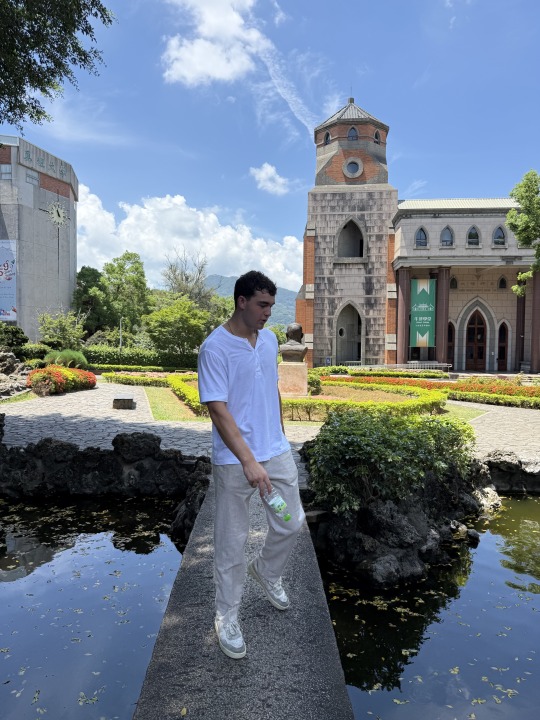
1 note
·
View note
Text
July 2 – Taipei 101 and the Urban Jungle
Yesterday was one of the most surreal experiences of the trip thus far: our group visited Taipei 101, the renowned skyscraper that formerly held the title of the world's highest structure. From the moment we walked in, everything felt larger-than-life: the glossy glass walls, the speed of the elevator that rushed us up to the observation deck, and, of course, the panoramic view of Taipei sprawled below us. I had seen innumerable images of the 101 before, but standing on the 89th level and seeing the clouds swirl about us gave me a fresh perspective for what an engineering masterpiece it is.
We then ate Din Tai Fung for dinner, which is located at the base of the tower. I'd heard a lot of good things about their xiaolongbao (soup dumplings), and they lived up to expectations. We shared dishes of steamed dumplings, noodles, and sautéed vegetables, and each meal was warm, rich, and seasoned. With our stomachs full, we went around the plaza and other retail areas, stopping at stores and taking in the nightlife of Taipei. During my tour, I learned about the tuned mass damper inside the 101, which is a massive pendulum that helps keep the structure stable during typhoons and earthquakes. It's an unusual and excellent combination of physics and architecture.
Academic Reflection
In addition to enjoying breathtaking vistas, visiting Taipei 101 offered an opportunity to discover how Taiwan has used engineering and ingenuity to adapt to its own natural environment. The tuned mass damper, a massive, golden pendulum dangling close to the top of the structure, caught my attention the most. It was unlike anything I had ever seen. It is intended to lessen the swaying brought on by strong winds and earthquakes, both of which are frequent in Taiwan. I became aware of how much planning goes into ensuring that a structure like this can stand tall and safely in an area that frequently experiences seismic activity after seeing it in person.
The fact that the damper is prominently displayed, complete with viewing platforms and educational videos, rather than being tucked away like a utility, caught my attention as well. That opened my eyes to the fact that engineering may be not just useful but also instructive and even aesthetically pleasing. I also saw a tiny display within the structure that presented macaque monkeys and other native species from Taiwan. It served as a modest but significant reminder that nature is always present, even in the middle of a metropolis full of glass, steel, and high-end shops. As we continue our exploration of Taiwan, I'll be thinking more about that relationship between contemporary development and the environment.
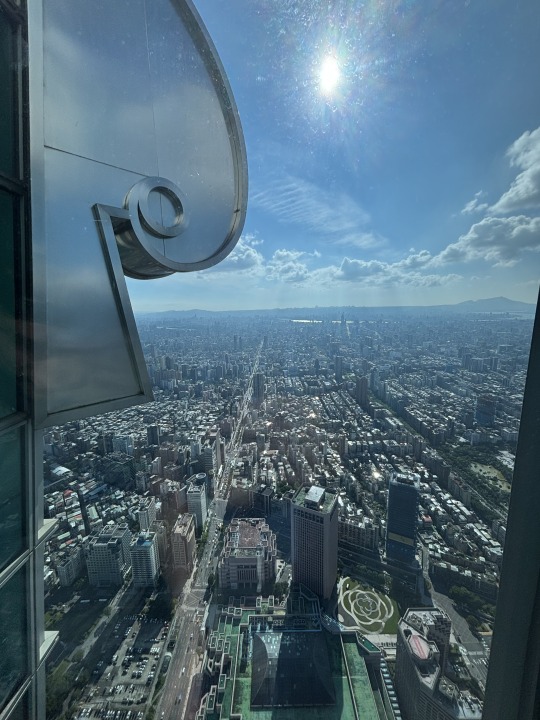
2 notes
·
View notes